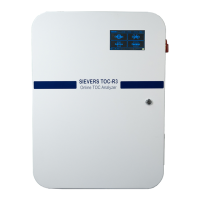SYSTEM DESCRIPTION
Chapter 2
............
Sievers TOC-R3 Operation and Maintenance Manual
DLM 95000-01 EN Rev. A 39 © Veolia 2023
• “TC Method” on page 39
• “NPOC Method” on page 39
TC Method
The TC Method determines Total Carbon (TC) which is all species of carbon contained
in the sample including Total Organic Carbon (Dissolved, Particulate, Volatile) + Inorganic
Carbon (TIC).
A sample, containing all species of carbon, is injected into the Furnace and oxidized with
no additional preparation steps prior to injection. After oxidation the resulting CO
2
is
measured via the NDIR Detector.
The TC Method is suitable for analytical applications where TIC values are negligible
compared to TOC values. This method uses no reagent and is the fastest Method
available.
NPOC Method
The NPOC Method is the direct determination of the Dissolved Organic Carbons (DOC)
and is an important part of the organic particulates (particle size up to 2 mm). This
Analytical Method is suitable for most analytical applications.
NPOC is measured by adding acid to the sample and suppresses the pH to < 2. At this
pH any IC in the solution is converted to CO
2
by the acid. Then, CO
2
-free gas is bubbled
through it to remove that CO
2
. A portion of the sparged solution is then introduced into the
Furnace where the organics in the solution are oxidized to CO
2
and are subsequently
measured in the NDIR.
The peak area of the CO
2
content then corresponds to the NPOC value.
Purchasable Analytical Methods
• “TIC Method” on page 39
• “TOC diff Method (TOC)” on page 40
• “TOC add Method” on page 40
• “Purgeable/Volatile Organic Carbon (POC/VOC) Measurement” on page 40
• “TNb Measurement” on page 40
TIC Method
The measurement of Total Inorganic Carbon (TIC) Method represents the inorganic
carbon content of a sample, which must be acidified and then stripped of resulting CO
2
.
As before, the carbon dioxide is measured in the NDIR Detector, and the TIC
concentration is calculated. This Method is not oxidized but instead sent straight to the

